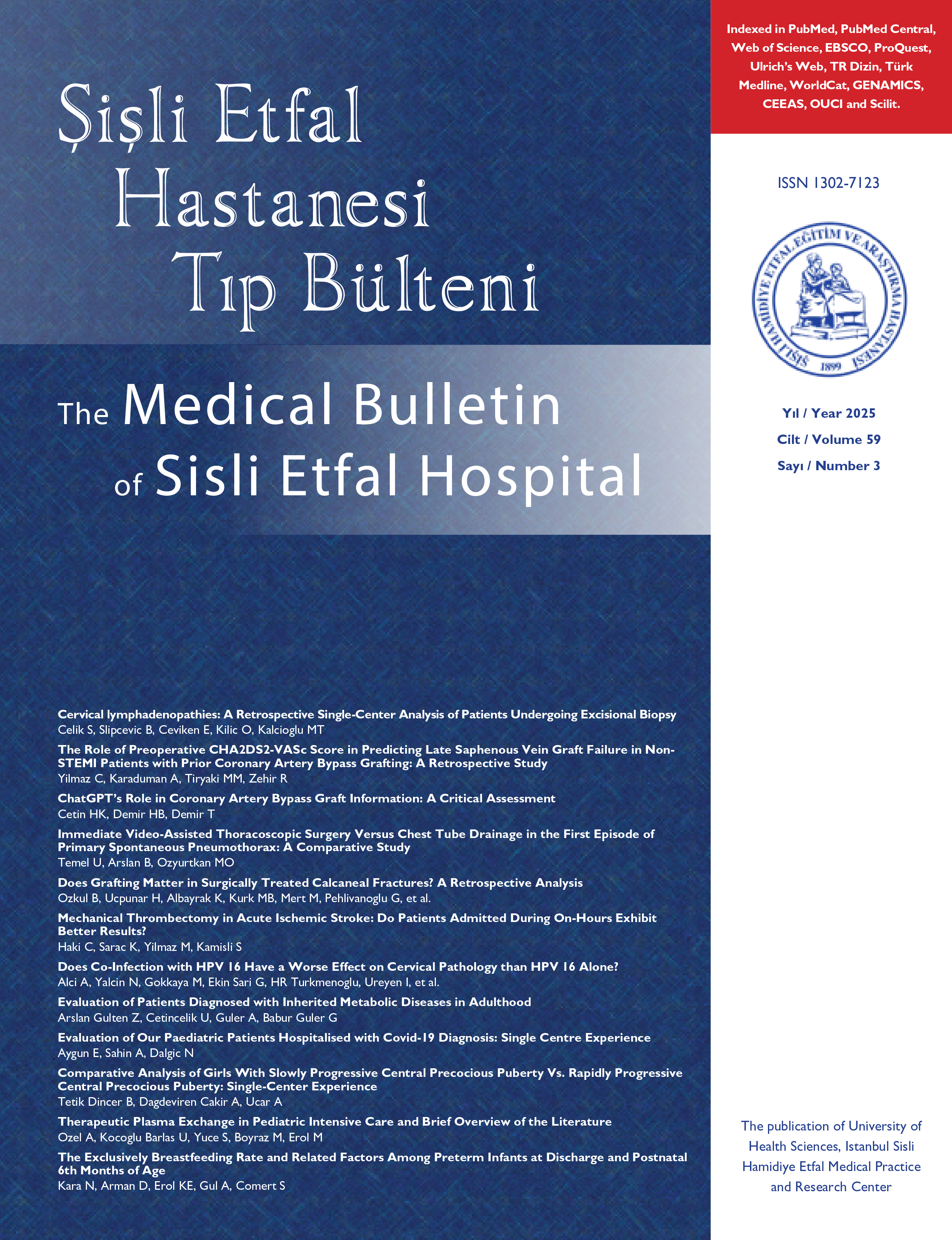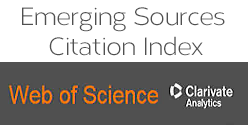
Prognostic Value of Epicardial Fat Volume Quantification Related to Coronary Artery Calcium Score and Degree of Stenosis on Coronary CT Angiography
Ahmet Mesrur Halefoglu, Ugur Yanc, Esra BelenDepartment of Radiology, University of Health Sciences Türkiye, Sisli Hamidiye Etfal Training and Research Hospital, Istanbul, TürkiyeObjectives: Epicardial fatty tissue volume (EFV) is regarded to be an important parameter in the evaluation of coronary artery disease (CAD). The aim of our study was to investigate the prognostic value of EFV measurements related to age, gender, coronary artery calcium score (CCS) and CAD severity through coronary computed tomography angiography (CCTA).
Methods: We retrospectively evaluated a total of consecutive 688 patients who were either asymptomatic but had a positive family history, or had typical or atypical symptoms suggesting the presence of CAD. They all underwent CCTA examination with multiplanar reformat (MPR), maximal intensity projection (MIP), and myocardial three dimensional (3D) volume rendering (VRT) images were obtained. We calculated CCS, coronary artery plaque stenosis degrees, the number of main coronary arteries involved and the EFVs for each patient. Finally, the relationship between the EFVs and all other parameters were analyzed by performing the Pearson and Spearman correlation analysis.
Results: We found a statistically significant difference between the genders of the patients where males presented higher EFVs than females (p=0.001; p<0.01). The correlation between the presence of CAD and the number of main vessels involved with EFVs was also statistically significantly higher in the analysis performed with the student t- test (p=0.001; p<0.01). There was a statistically significant but weak positive correlation between the ages of the patients (r=0.271; p=0.001; p<0.01), calculated total CCSs (r=0.149; p=0.001; p<0.01) and the degree of vessel stenosis determined based on coronary artery disease reporting and data system (CAD RADS) (r=0.347; p=0.001; p<0.01) and their EFV measurements.
Conclusion: We assume that, the quantification of EFV performed by the CCTA technique is a potential novel method and hence, can guide clinicians in predicting the presence and severity of CAD.
Keywords: Coronary artery calcification, coronary artery disease, coronary artery stenosis, coronary computed tomography angiography, epicardial fat volume
Koroner BT Anjiografide Koroner Arter Kalsiyum Skoru ve Stenoz Derecesinin Saptanmasında Epikardiyal Yağ Hacminin Hesaplanmasının Prognostik Değeri
Ahmet Mesrur Halefoglu, Ugur Yanc, Esra BelenTürkiye Sağlık Bilimleri Üniversitesi, Şişli Hamidiye Etfal Eğitim ve Araştırma Hastanesi, Radyoloji Kliniği, İstanbulAmaç: Epikardiyal yağ dokusu volümü koroner arter hastalığının değerlendirilmesinde önemli bir parametre olarak kabul edilir. Çalışmamızın amacı, bilgisayarlı tomografi koroner anjiografi ile epikardiyal yağ volümü ölçümlerinin yaş, cinsiyet, koroner arter kalsiyum skoru ve koroner arter hastalığı şiddetini belirlemedeki prognostik değerini araştırmaktı.
Yöntem: Çalışmamızda, asemptomatik fakat pozitif aile öyküsü olan ya da koroner arter hastalığı varlığını düşündüren tipik veya atipik semptomları olan toplam 688 ardışık hastayı geriye yönelik olarak değerlendirdik. Hastaların tümüne bilgisayarlı tomografi koroner anjiografi yapıldı ve mültiplanar reformat, maksimal intensite projeksiyon ve üç boyutlu miyokardiyal volüm rendering görüntüler elde edildi. Her hastanın koroner arter kalsiyum skoru, koroner arter plak darlık derecesi ve tutulan ana koroner arter sayısı ve epikardiyal yağ volümü hesaplandı. Son olarak, epikardiyal yağ volümleri ile diğer tüm parametreler arasındaki ilişki, Pearson and Spearman korelasyon analizi yöntemi ile araştırıldı.
Bulgular: Erkeklerin epikardiyal yağ volümleri kadınlara göre daha yüksek olup, hastaların cinsiyetleri arasında istatistiksel olarak önemli bir fark bulundu (p=0.001; p<0.01). Koroner arter hastalığı varlığı ve tutulan ana koroner arter sayısı ile epikardiyal yağ volümleri arasında da student t test ile yapılan analizde istatistiksel olarak oldukça yüksek bir korelasyon saptandı (p=0.001; p<0.01). Hastaların yaşı (r=0.271; p=0.001; p<0.01), hesaplanan total koroner kalsiyum skorları (r=0.149; p=0.001; p<0.01), koroner arter hastalığı raporlama ve veri sistemine (CAD RADS) göre belirlenen koroner arter darlığı derecesi (r=0.347; p=0.001; p<0.01) ile epikardiyal yağ volümü ölçümleri arasında istatistiksel olarak önemli fakat zayıf pozitif korelasyon saptandı.
Sonuç: Bilgisayarlı tomografi koroner anjiografi tekniği ile epikardiyal yağ volümü hesaplanmasının potansiyel olarak yeni bir metod olduğunu ve koroner arter hastalığının varlığını ve şiddetini tahmin etmede klinisyenlere yol gösterebileceğini söyleyebiliriz. (SETB-2024-11-195)
Anahtar Kelimeler: Koroner arter kalsifikasyonu, koroner arter hastalığı, koroner arter darlığı, bilgisayarlı tomografi koroner anjiografi, epikardiyal yağ hacmi
Manuscript Language: English



















